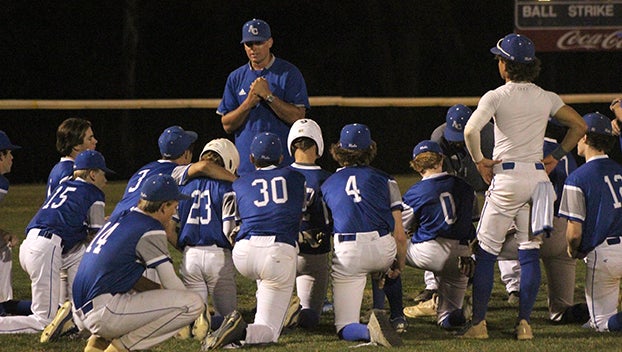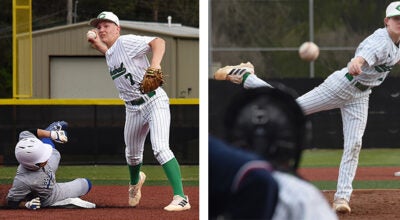Local athletes face adjustments when switching sports
Published 12:01 am Friday, January 4, 2013

Cathedral High School seniors Dale Matheney, left, and Dakota Vaughn run foot skill drills Thursday afternoon during the first soccer practice back from winter break on the football field. Both Matheney and Vaughan played football for Cathedral and had to adjust to a different kind of kind of physical conditioning required for soccer. (Lauren Wood \ The Natchez Democrat)
NATCHEZ — Going from football to soccer is easier for Dale Matheney than going from soccer to football.
After spending the fall as a placekicker for the football team, the Cathedral High School senior midfielder/forward made a quick transition to soccer. As the seasons changed for different sports, Matheney is one of many local athletes that had to adjust to a different style of play.
“Soccer is my first sport, and I take it pretty seriously,” Matheney said. “The adjustment to playing football is harder.”
Matheney was a first-year football player for the Green Wave as a placekicker, and he said being a soccer player and being a kicker in football are two very different experiences.
“Soccer is more hands-on, more active,” Matheney said. “You move a lot more, and you’re thinking on your feet. There’s not a set of predetermined plays like in football. In soccer, you get to do it in your own way.”
Teammate Dakota Vaughan, who was an offensive lineman in football before taking over at sweeper for the soccer team, said the two positions complement each other as far as skill sets go. As a sweeper, he’s the final line of defense before the goal, so good footwork is a necessity as Vaughan’s position — just like on the offensive line, he said.
“As an offensive lineman, you need short, choppy, quick steps to drive the person where you want them to go,” Vaughan said. “It’s the same with soccer, except it’s to keep the ball away from the goal.”
As a kicker, Matheney said the way you prepare for a kick is different between the two sports. The mechanics of kicking between the two sports can also differ at times.
“There’s more of a rush in soccer,” Matheney said. “In football, you have more time to think. In football, you use the top part of your foot, but in soccer, you can use any side. It just depends on the situation.”
One big contrast between soccer and football is the type of conditioning each sport requires, Vaughan said.
“It’s a completely different kind of conditioning,” he said. “You wouldn’t think so, because you run in both, but in football, it’s six seconds of action then a break. In soccer, it’s constant jogging and running.”
Matheney said the adjustment from football to soccer can be a little difficult at first, but it comes naturally for him.
“It’s hard to get back in the swing of running laps around the field, but other than that, it’s pretty easy,” Matheney said.
Vaughan said he’s glad he played both sports, because one did help get him in shape for the other.
“If I didn’t have football, I’d have a hard time adjusting to soccer,” Vaughan said. “It’s similar enough to where it’s easier for me to adjust. (Head football) coach Ron (Rushing) held up-tempo practices. We didn’t do many sprints, but the pace at which he kept us practicing kept up our conditioning.”
Football to track and field
Natchez High School’s Amos James III is fast.
He used that speed to cover wide receivers for some of the best high school football teams in the state of Mississippi in the fall. But right after the final whistle blew, James immediately turned his attention to the oval ring that surrounds the football field.
The senior says there is actually a greater difference in running on the football field than running on the track than some people may think.
“It’s a big difference between going from focusing on strength (in football) to focusing on speed (in track),” James said. “There is also a big difference between football shape and track shape.”
James said it takes him about two weeks to transition from football conditioning to track, and his workout shifts from less weight lifting to more focus on running technique.
There is still plenty of running in football, and the Bulldogs spend plenty of time conditioning, but James said he does not mind the amount of time he spends running during a school year.
“I really don’t get tired of running,” he said.
This season, James was honored with an appearance in the National Underclassmen Combine All-American Game as a cornerback, but he said he still prefers track despite his ability on the football field.
“You can see more people, and there is more competition, and it’s more individual,” he said.
Basketball to cheerleading
Sometimes, going from one sport to another happens in a matter of minutes.
Right after she’s done playing for the varsity girls, Trinity Episcopal Day School point guard Gabby Knight changes into her cheerleading uniform to cheer on the varsity boys.
“I think it’s worth is, because it’s making me more versatile,” Knight said of doing both.
That doesn’t mean it’s easy doing one right after the other, though.
“It’s very hard, because you’re body is sore, tired and sweaty,” Knight said. “I know it’s my job to cheer the guys on, and I just push through. I committed to it, so I can’t just drop it.”
Knight said she puts the same amount of time into both sports, though managing her schedule does get a little tricky at times.
“Scheduling practices around basketball and cheerleading is tough,” Knight said. “I have to make sure they’re spread out correctly, and I have to keep the coaches informed.”
Softball, basketball, track and field
The transition from sport to sport has become easier for Adams County Christian School senior Nikki Worthey.
The softball, basketball and track athlete had trouble moving from sport to sport when she began playing three sports in seventh grade, but it has become easier each season, she said.
“It used to be way more difficult when I didn’t understand what you were supposed to do,” she said. “Now it’s like instinct. It just automatically comes to me.”
Worthey said it is tough to go from a sport that requires less continuous running, like softball, to basketball where she has to run constantly.
“It’s really tough, especially if we practice every day,” she said. “It usually takes about two weeks, three tops, to get into (basketball) shape.”
It is also difficult for her to get her shot back once she leaves the diamond for the court.
“It takes probably two weeks or so, but it’s never completely right,” she said. “It would absolutely be easier if I played year-round.”
But Worthey said her most difficult transition in terms of conditioning is when she has to get back on the track as a sprinter.
“Track is probably the hardest sport to get back in shape for, because you have to run so far,” she said. “Basketball is just short sprints and jab right or left. You only have so far you have to run. Basketball sprints are a lot different than a full-out 200 meters.”




